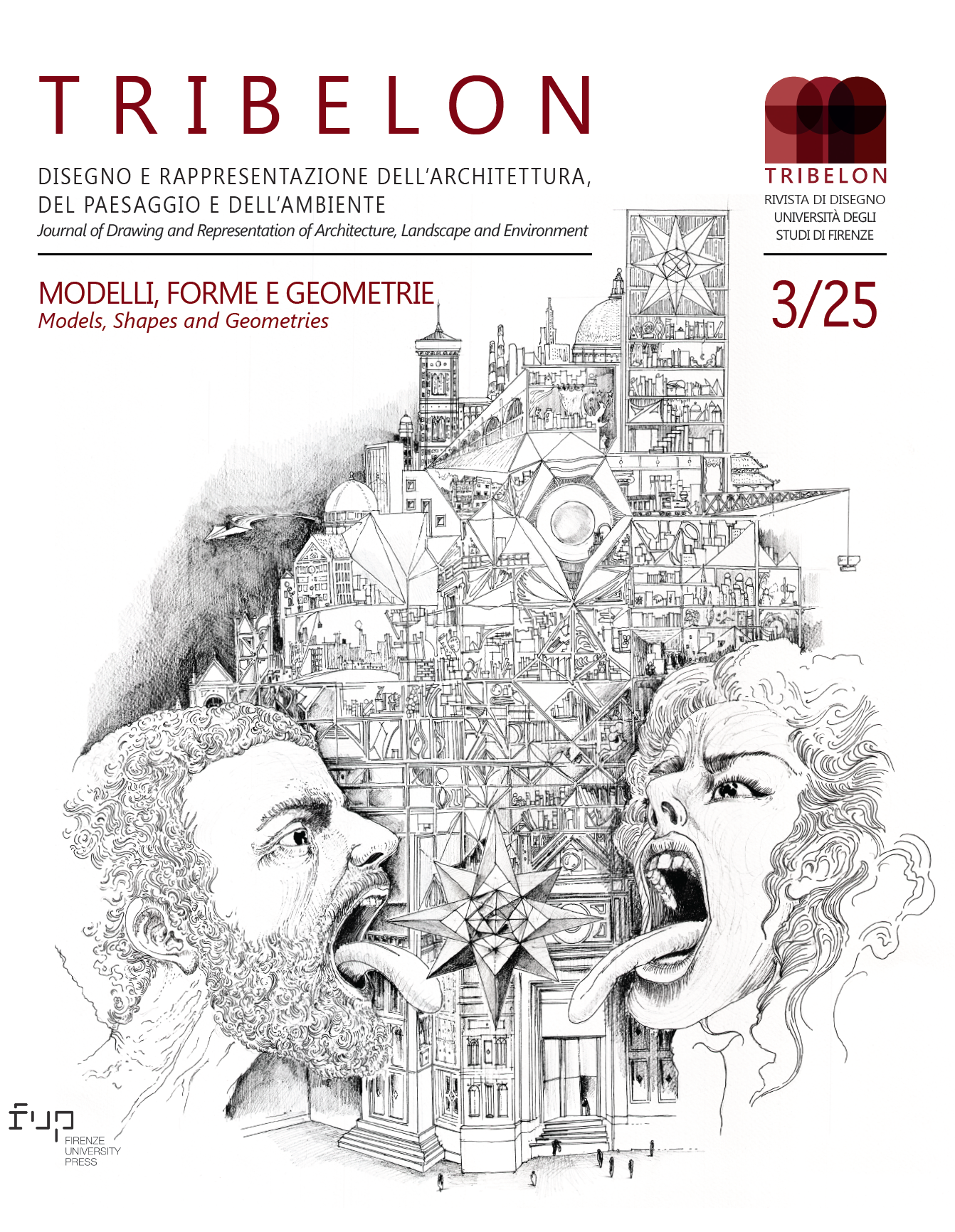Published 2025-06-09
Keywords
- Descriptive Geometry,
- Form Conception and Control,
- Model
How to Cite
Copyright (c) 2025 Graziano Mario Valenti, Laura Carlevaris

This work is licensed under a Creative Commons Attribution 4.0 International License.
Abstract
The paper aims to offer a critical reflection on the current research panorama in the field of Descriptive Geometry. What is discussed here is a path consolidated over time through the constant research activity of a group of scholars. The reflections presented aim to bring together both the scientific and historical, theoretical and methodological foundations of the discipline, as well as the most recent areas of research, with the attention always focused on applications and the contribution offered by the continuous and accelerated transformation of tools. Through an illustrative collection of some “emerging” research identified in a national and international milieu, the contribution observes the state of the art of the field of study, focusing on different paths: some obvious and established, others forgotten or little frequented, which appear fertile and rich in potential. An analysis that observes, with equal dignity, basic, applied and didactically oriented research. An analysis, again, that ranges from philological and methodological rigor, proper to analog drawing, to the expressive derogations in the representation of form apparently granted by the latest digital technologies. Finally, an analysis that submits to the evaluation of the scientific community some possible critical issues to come: real potential “emergencies,” which may require an extraordinary effort to be contained, addressed, resolved, assimilated and, above all, shared.
References
- C. Bianchini, M. Docci, La Scuola romana del Disegno nel centenario della Facoltà di Architettura della Sapienza Università di Roma, in Disegnare. Idee, immagini, 61, 2020, pp. 68-79.
- L. Carlevaris, L. De Carlo, R. Migliari (a cura di), Attualità della Geometria descrittiva. Seminario Nazionale sul rinnovamento della Geometria descrittiva, Gangemi editore, Roma 2012.
- L. Carnevali, M. Fasolo, F. Lanfranchi, Il Disegno e la Scuola Superiore di Architettura / Drawing and the Advanced School of Architecture. In A. Arena, M. Arena, R.G. Brandolino, D. Colistra, G. Ginex, D. Mediati, S. Nucifora, P. Raffa (a cura di), Connettere. Un disegno per annodare e tessere / Connecting. Drawing for weaving relationships, Atti del 42° Convegno dei Docenti delle Discipline della Rappresentazione, FrancoAngeli, Milano 2020, pp. 238-259.
- A. Casale (a cura di), Geometria Descrittiva e rappresentazione digitale. Memoria e innovazione, vol. I e II, Edizioni Kappa, Roma, 2013.
- L. De Carlo, R. Migliari, Un manifesto per il rinnovamento della Geometria Descrittiva, in B. Aterini, R. Corazzi (a cura di), La Geometria tra didattica e Ricerca, Atti del Convegno internazionale, Firenze 17-19 aprile 2008, Alinea, Firenze 2008, pp.103-104.
- M. Fasolo, R. Migliari, Decio Gioseffi e La prospettiva come “forma simbolica”, in Disegnare. Idee immagini, n. 57, 2018, pp. 54-57.
- R. Migliari, La prospettiva e Panofsky, in Disegnare. Idee, immagini, n. 31, 2005, pp. 28-44.
- R. Migliari, Descriptive Geometry: From its Past to its Future, in Nexus Network Journal, n. 14, 2012, pp. 555-571.
- R. Migliari, La Geometria descrittiva nel quadro storico della sua evoluzione dalle origini alla rappresentazione digitale, in L. Carlevaris, L. De Carlo, R. Migliari (a cura di). Attualità della Geometria descrittiva. Seminario nazionale sul Rinnovamento della Geometria descrittiva, Roma dicembre 2009 - marzo 2010, Gangemi editore, Roma 2012.
- G. Monge, Géométrie Descriptive. Leçons données aux Écoles Normales, Programme: 2, Baudouin, Paris 1798.
- Voce “Modello”, in Dizionario di Filosofia, Treccani, Roma 2009.
- M. Pavignano, Models for Geometry: Thoughts for an Interdisciplinary Dissemination, in L. Carlevaris, G.M. Valenti (a cura di). Digital & Documentation, vol. 3. Reading and Communicating Cultural Heritage, Pavia University Press, Pavia 2023, pp. 190-203.
- J. Sakarovitch, Épures d’architecture. De la coupe des pierres à la géométrie descriptive. XVIe-XIXe siècle, Birkhäuser, Basel-Boston-Berlin 1998.
- R. Taton, L’école royale du Génie de Mézières. In R. Hahn and R. Taton (editors). Écoles techniques et militaires au XVIIIe siècle, Hermann, Paris 1986, pp. 559-615.
- R. Taton, René. Enseignement et diffusion des sciences en France au XVIIIe siècle, Hermann, Paris 1964.
- G.M. Valenti, in MI Il modello integrato, in R. Migliari (a cura di), Disegno come modello, Edizioni Kappa, Roma 2004, pp. 59-62.
- G.M. Valenti, Di segno e modello, FrancoAngeli, Milano 2022.
- To see other references, click on: https://drive.google.com/file/d/1RM4Y6RFMz3LgMftlOzM3Z6agbiMqnr5P/view


